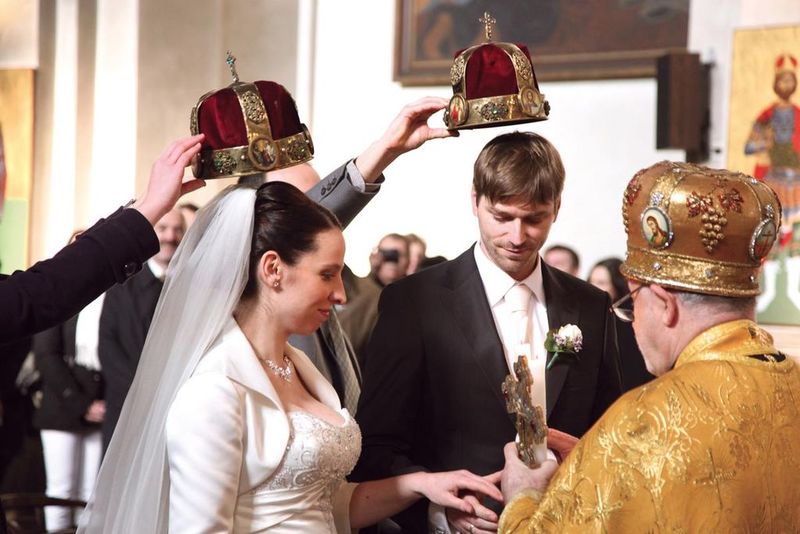Russian Wedding
Russian weddings begin with a civil ceremony at the state office "ZAGS," often followed by an optional religious ceremony in an Orthodox church, and the celebrations typically last two or more days. Traditional elements include the groom paying a symbolic ransom for the bride, the crowning ceremony during the religious service, and a lively reception with toasts, glass-breaking for good luck, and the offering of bread and salt by the parents to symbolize prosperity. The festivities continue with a second day of food, drink, and dancing, showcasing the enduring and joyous nature of Russian wedding customs.
Russian Weddings
Engagement in Russia traditionally does not include engagement rings. But in modern society these rings appear as the influence from abroad. All Russian couples must get married in the state office known as "ZAGS". A religious wedding ceremony is an optional one. The wedding usually lasts for two or even more days.
According to an old Russian folk belief it is not good to get married on Wednesday and Friday. The 13th day in month was considered unlucky. On the other side the so called lucky dates were 3rd, 5th, 7th and 9th.
A bride must wear her wedding dress and shoes for the first time. Otherwise she will experience some bad events in the future.
One of several things that the happy couple must do is to find a toastmaster ("tamada"). His or her role is quite important. The toastmaster's duties among other things include organizing the entertainment at the wedding reception.
Usually it is the groom who buys the wedding rings. But as always there are exceptions. Wedding rings are golden ones often decorated with a precious stone. They are worn on the ring finger of the right hand.
Before the wedding ceremony there is a funny event initiated by the bride's parents. They sort of kidnap the bride and ask the groom to pay a ransom. He has no choice. He pays a small amount of money. Some jewellery may satisfy the "kidnappers". On some weddings after first payment the groom gets a false bride. Often this "bride" is a disguised man. After the groom gives money again he finally gets a real bride.
Now everything is ready for the wedding ceremony to begin. The couple is accompanied by two witnesses ("svideteli"). Those who wish the religious ceremony go to a church.

Most Russians are Orthodox Christians. The church wedding ceremony can last up to two hours. The Orthodox Christian wedding ceremony ("venchanie") consists of two parts - the betrothal and the crowning.
Nowadays betrothal is held at the beginning of the wedding ceremony. It is held at the church entrance. The priest blesses the bride and groom. There they get lit candles. They hold them during whole wedding ceremony. There is also a prayer and reading from the Bible.
Then there is a very important part of the wedding ceremony known as the crowning. The couple stands on a special piece of cloth that symbolizes a new life. The bride and groom say that they are entering the wedding with their own free will.
A crown is put on both bride's and groom's heads. The couple then shares a cup of wine. There is a prayer. The priest guides the couple around a special table on top of which there is the Bible. They move around the table three times. The couple holds their hands together. A priest's stole is wrapped around their hands.
After yet another prayer the couple is declared married. The couple is also blessed. The wedding crowns are removed.
The couples in Russia usually go to the park or in front of some important building. There the wedding photos are made. After the end of this rather important photo session the couple goes to the place where the wedding reception ("gulyanka") is held.
A Russian wedding reception starts with the toast made by the couple's cousin or friend. Some glass breaking happens then. People throw their glasses on the floor. Each broken glass means good luck.
After the toast guests shout "Gorko! Gorko!" The couple then kisses. They traditionally continue to kiss until the bitter taste of vodka is removed.
One of the most important Russian traditions held at the wedding reception is one where both bride's and groom's parents offer bread and salt to the newlyweds. They symbolize a long and prosperous life. The partner who takes larger bite is believed to be the dominant one.
The wedding reception includes yet another kidnapping of the bride. This time she is kidnapped by her friends. The groom has to pay some money to get her back.
After short rest the couple and their guest start the second day of the wedding festivities. It means more food, drink, singing and dancing.
References
Traditional Russian Wedding
http://masterrussian.com/russianculture/russian_wedding.htm
Russian Wedding Tradition
http://www.barynya.com/wedding.stm
Russian Wedding Traditions
https://russiancultureblog.wordpress.com/2012/12/06/russian-wedding-traditions/
Russian wedding traditions: Matchmaking
http://www.advantour.com/russia/traditions/matchmaking.htm
Image(s)
Russian orthodox wedding (photo by VitVit)
https://commons.wikimedia.org/wiki/File:Pravoslavn%C3%A1_svatba.jpg
Creative Commons - File:00 0623 Red Square in Moscow.jpg